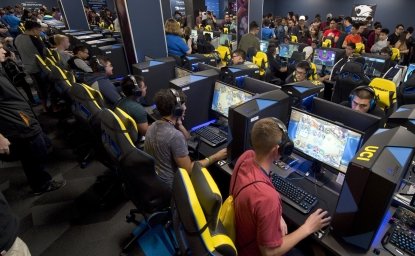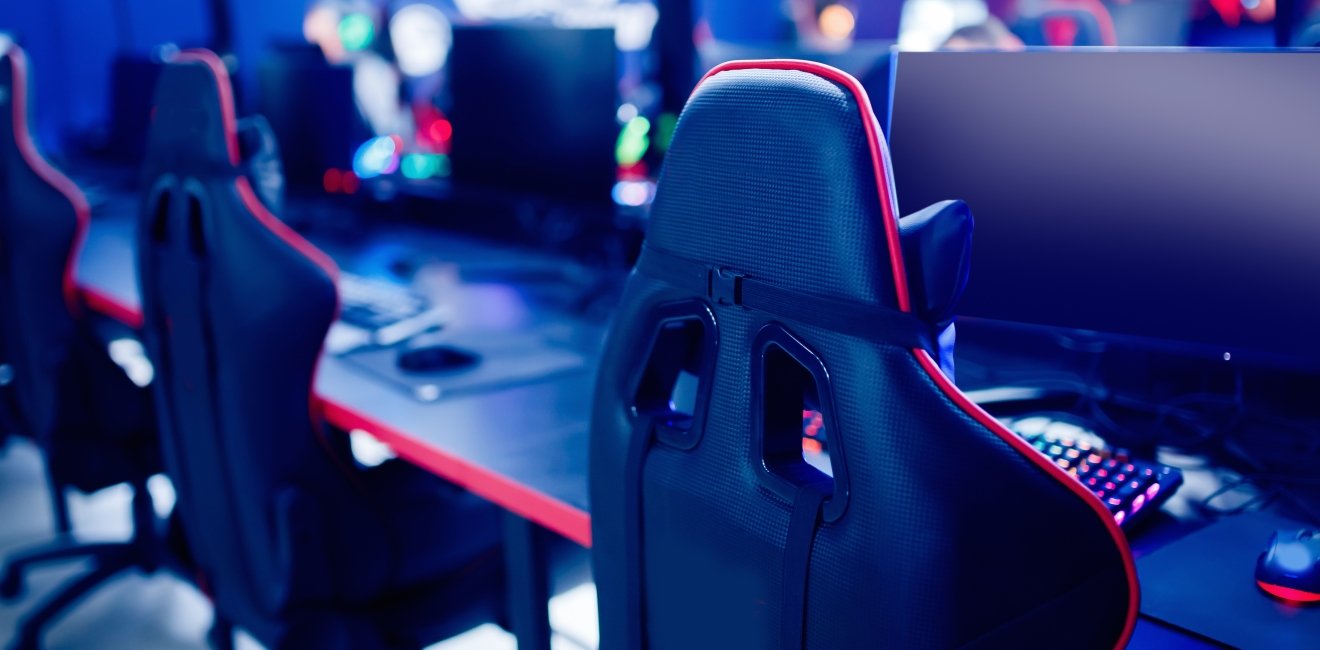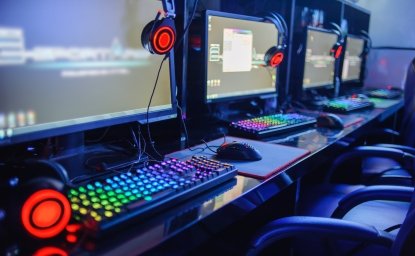Esports, the competitive play of video games, is an industry that is in many ways outpacing itself. It is a broad term that encompasses game titles from League of Legends to Fornite to Rocket League to Counterstrike, much as traditionally, the term ‘sport’ refers to multiple types of sport, such as football, basketball, baseball, fencing and water polo. The industry is worth approximately $1 billion as of 2019, and projected to be worth $4.28 billion by 2027. The top players in the world have a networth measured in millions. Part of this network is based on viewership; as of 2019, estimated esports viewership measured approximately 454 million; during the pandemic, when many traditional sports struggled, esports viewership grew. In short, the infrastructure and competition level of esports looks a lot like a sport, even if you can’t find it officially recognized by the Olympics. Yet.
To capture this interest and meet student demands, colleges and universities are starting to burst with programs to compete in esports. But which league, which game, style of club, or even how to fit the esports program on campus varies from school to school; there is no one way to “do” esports. Unlike traditional sports, which may have organizations like the NCAA (which passed on an opportunity to include esports, according to an article from the Washington Post), there is not a unified league for collegiate esports. As there is not a unified league, protections given to student athletes in traditional sport are absent in the field of esports.
This is a critical concern because esports is different from sports in one critical aspect: it is played in a largely seated position and based on repetitive clicking, typing, or button mashing. Health experts know that staying seated for extended hours is not good for our health, and professional esports players may spend as much as 12 hours a day playing a game because it is seen as necessary in order to remain competitive. It is not merely the act of sitting for long hours, but also the game play itself; a potential result of this is that, more and more, esports players are reporting substantive injuries, from torn tendons to vision issues, mental fatigue and burnout. Further complicating the issue is the fact that there is limited research examining the impacts of esports, and there are no unified guidelines supporting best practices for esports.
A critical examination is needed to understand the risks and benefits of esports, and ways to prevent these injuries. In early 2021, Elizabeth M H Newbury, PhD, Director of the Wilson Center’s Serious Games Initiative, and researchers Dr. Stuart Best, University of Kentucky and Ellen Zavian Esq., George Washington University, hosted an event with players, doctors, industry and government leaders on the topic of health and collegiate esports players. A key objective of this meeting was to assess what the research agenda should be for esports and health, and what are the current best practices in the field. Below is an overview of that discussion, and some preliminary suggestions for ways to progress both the research and policy agenda.
Esports Collegiate Scene
Health is a critical issue in esports due to the nature of those who play esports. Besides the novelty of the field and the way in which it is played, esports differs from traditional sports in the age of its players at the competitive level. Although rare, some esports players sign on to professional teams as young as eight years old. Esports professional players tend to be younger than professional players in traditional sports: while the average age of a professional in traditional sports like football or basketball might be approximately 26, the conventional wisdom is esports players begin to retire by 25 years old. Why so early? It’s the nature of esports: it is how fast you can click. Therefore, by 25 years old in most esports, the general sentiment is that a player's reflexes tend to decline; the ideal years to play are late teens to early 20’s in order to have the reflexes to play at a professional level.
It is also important to recognize there is no singular pipeline on how players may compete in a professional capacity. Players do not go up from high school, into college, and then become recruited for a professional team as is a common practice in some traditional sports. The Washington Post exemplified a concern among players in the United States weighing the choices of going professional esports player, or going to college. When players are imagining their peak performance might come at the same time as college, the decision is unclear.
Nonetheless, the collegiate esports scene is rapidly growing, with programs, leagues, and the overall infrastructure to give students the opportunity to compete in esports -- even if it is not a “professional” level but more comparable to the NCAA. For example, there are over 170 participating colleges and universities in The National Association of Collegiate Esports (NACE), one of the largest organizations founded to provide a tournament structure to colleges and students interested in participating in esports. A division of the National Association of Intercollegiate Athletics (NAIA), NACE offers a wide range of game genres and titles, from Fornite to Madden, and has offered $16 million in scholarship money. Tespa, an esports league headquartered in Activision Blizzard and sponsored by such brands as Coca-Cola, has competitive programs around just three game titles: Call of Duty, Hearthstone, and Overwatch. Within its context, it claims to reach 1,350+ schools, 40,000+ students, and have handed out $3.3 million in scholarship money. Similarly, traditional sports leagues, like the Mid-American Conference (MAC), are forming their own esports divisions.
These, of course, do not encapsulate all the competitive leagues, nor the wide range of club-level esports offered. Quite simply, the growth in collegiate esports has led to a wide range of methods on how to get esports on campuses and the infrastructure needed to support esports, yet there is little research that explores the optimal way to do so.
Growing Health Concerns
While many players are concerned about capitalizing on their peak performance years before they retire, reflexes are not the only reason why someone might retire. Many esports players are retiring early not because they cannot compete with teenager reflexes, but from getting sick or injured. A notable example of this is Jian “Uzi” Zihao, a gaming legend in China, who retired at the age of 23. In announcing his retirement, he cited reasons including a declining mental health, ‘insurmountable stress,’ and a poor diet that has led to Type-2 diabetes. Stories like this are becoming more common.
Much of the evidence of health in esports is as preliminary as the rest of the field. Some notable exceptions include an overview of literature published through the Journal of Sport Health Science and a call for protocols through the Journal of the American Osteopathic Association. In these cases, a key flag for research is the joint emphasis on both the physical and mental impediments from esports players. Many of the physical concerns that have been seen in esports are: sleep disturbances, vision issues, overuse injuries (like carpal tunnel), even metabolic concerns from energy drink consumption. Preliminary research out of the University of Kentucky, led by Dr. Stuart Best, indicates that heavy gamers (that is, players who game for over two hours per day) may be at a greater risk for higher rates of back and joint pain and higher incidents of difficulty sleeping.
Physical health concerns are just the beginning as there are also mental health concerns, such as stress, mental fatigue, and burnout. The mental health concerns were particularly marked as part of the discussion we hosted, as this was seen as a side effect of gaming culture, namely the sense of “grind culture” as one speaker put it. Grinding is parlance for the act of playing a game over and over again with the eye for either completion or to perfect skill in the game. The sentiment is similar to the professionalization of sport, namely, the game becomes not an activity for strictly fun but more of a job (see Dr. T. L. Taylor's Raising the Stakes for a more robust discussion on labor in esports) that was seen as putting psychological pressure on those who are competing in esports.
To support players, preliminary research noted some emerging trends. Ellen Zavian from The George Washington University, noted that the field of professional esports is developing an ecosystem around the esports athlete: physical therapy, sports medicine and primary care, nutritionists, athletic trainers, optometrists and sports psychologists. While these are becoming more common practice among professional teams, the majority of college students do not have access to these resources, particularly if they are in a club team setting. Likewise, one speaker indicated that there is a growing practice in professional esports health to increase awareness around these issues and incorporate analogous fields of study (such as sports medicine) to help support pro-gamers. However, the critical concern was that there were sparse, decentralized resources for collegiate esports players, and limited regulation or fact-checking for practices. Research should identify not only what the current practices are, but how to provide consistent guidelines to support college esports players.
Positive Health Impacts
Although the negative impacts of esports are critical to assess from a preventative standpoint, experts are also quick to outline the positive impacts of esports. As a perspective for future research, the ways in which esports can facilitate positive impacts--particularly in terms of mental health--was of key interest. As much as there were concerns of the stress of grind culture, the activity of esports is one that also allows for fostering social connection, a sense of belonging, and opportunities for development of soft-skills like leadership or skills like mental acuity.
Esports can have pro-social impacts. Particularly in light of the pandemic, when many are unable to gather in person, esports has thrived. Esports provides a sense of social connection and belonging for students. Even if someone does not directly engage with a wide network of friends through esports, sometimes the shared sense of community is enough to provide strong mental health benefits and positive feedback--much in the same way as being part of a sports community provides a shared sense of belonging. As a shared social experience, the general sense was that esports could be used in much the same way colleges and universities are using other activities, like sports: to build a sense of community.
Another positive health impact that came up through discussion deserves further exploration in the collegiate context, and that the positive impact esports may have on cognition. Early research suggests that even in amateur competition, participants report improvements to cognitive outcomes. Mental acuity is critical to esports play; many games rely on quickly adapting a strategy and responding rapidly to stimuli within the game itself. Within the military context, these parallels are already being drawn out to illustrate the impact esports can have on cultivating decision-making, strategic thinking, and rapid response. There are some that suggest this provides an opportunity to better understand the neurocognitive impacts in a competitive environment.
Future research should examine the extent of these positive impacts, contributing to the broader legacy of game studies research in understanding the role of community, impact on cognition, and broader concerns on the positive impact video games, such as on soft-skill development like leadership or communication skills.
Key Barriers to Research
One concern when it comes to research into esports is how to draw the sample, with a lot of it tied back to the general lack of uniformity in implementation on college campuses -- but also broader concerns with the nature of esports. Much as in other forms of sport, there may be titles that are popular, but there is no firm boundary on what is or is not an esport. Researchers are challenged to ask which games to focus on for any sample; if examining a particular college club team, that team may be organized around a specific title. Historically in game studies, games have been sampled by the community surrounding the game -- e.g. EverQuest, World of Warcraft, League of Legends. The practices that surround one game may not be the same as those in another game due to the history of the game, the playerbase, the genre, and cultural history within gaming. What is normative behavior in League of Legends may not sit as well with Counter Strike or Just Dance.
Additionally, and perhaps even more problematically, the ways in which esports is positioned within the overall collegiate scene is disparate. Due to the lack of uniformity in practice, this may influence the conditions in which esports is played and the ways in which players orient towards health concerns. For example, teams that have a devoted arena or training environment, a coach, or other resources may have a different experience than those who do not.
Another key issue in understanding the state of esports in the collegiate scene is not just the institutions of higher learning, but the game developers themselves and the professional leagues fostered by those developers. For collegiate sports, there was a general sense that there was a ‘trickle down’ effect of esports set by the professional leagues that informed the tenor of the collegiate scene. As an example, the seasons, pacing, and very mechanics of the game are dependent on the publisher and the release schedule. The power of the developer in setting the tone of the game, the mechanics of the game, and the general sense of the ecosystem surrounding the game is necessary to understand from a health research perspective and should be incorporated into the analysis.
In general, the argument seemed to steer towards not viewing esports as an intervention or isolated experience, but as part of a broader ecosystem of practice with multiple points of influence that impact the player’s experience. Some of these are (potentially) within the player’s control; the environment within which they practice, the nutrition they eat, the time in which they spend on the game. At the same time, some of these are external pressures: the game’s design, where the club is positioned within the college environment, the season schedule, and the broader culture surrounding the game. Accounting for these multiple points of impact would lead to a better understanding of how esports player health can be supported.
Gender
There are significant concerns also in the sampling of those who are already playing esports, as it necessarily negates those who are not active participants in esports due to the current state of the field. Particularly, this was voiced in terms of gender.
For all intents and purposes, there are no physical barriers that prevent women from playing esports on parity with men. In the broader field of games, women play video games as often as men do. However, esports does not offer an equal playing field. According to a forthcoming study from SUNY Cortland, which sampled collegiate esports players in NACE, only 8.2% are women. This is disparity is reflected in the market economy of esports scholarships. A recent AP report showed that of a sample of 196 college programs, nearly 90% of esports scholarships are going to men, perpetuating a pipeline of inequity.
This suggests that in the context of health research, careful consideration needs to be paid to ensuring that findings should not sustain this gender division nor exclude those who are underrepresented in the field. Sampling all male teams, for example, could result in landmark guidelines that could not align with the health needs of differently gendered bodies. An extension of this conversation would be to be inclusive of demographics that, while may not be the majority now in esports, are still important to consider from a health standpoint and could still impact guidelines for the broader field.
Recommendations
It is clear that although esports and video gaming can be a positive experience for cognitive and social health, it is also a field that is requiring new protocols in sports medicine. For future pursuits into the research and implementation of esports at the collegiate level, some key considerations that need to be advanced are:
- Understanding the ecosystem of esports. Particularly in collegiate environments, research must account for the diversity of practices and lack of uniformity across campuses in how esports is institutionalized. This may in turn lead to differences in terms of the resources available and playing practices of those who are playing esports.
- Sampling by device, then by game genre. To avoid some of the problems of the generalizability of the field, one way forward would be to sample players not by a specific title first. Instead, focus on the physical ways in which players are joining a game--e.g. by computer, console--and then, to narrow the scope further, by gaming genre. For example, a sample might be derived from arcade style games, console, or computer, and then narrowed down to fighting games, MOBAs, or speed racing.
- Examining the positive impacts of esports. One way that games can be beneficial is through the sense of a shared social connection. In terms of mental health, there was an interest in if and how esports specifically can build a sense of a community and support positive social outcomes. Furthermore, research might explore the connections between esports and mental acuity, motivation, and ties to reflexes.
- Emphasizing equity in players. The state of play is not equal for women players, raising concerns that any research paradigm might oversample one demographic. This oversampling could in turn lead to guidelines that perpetuate inequalities. Any research paradigm should therefore examine players not just in terms of those who are actively participating now, but consider ways to build inclusion in esports.
With the amount of investment going into esports, and the growing concern at the professional level for the safety of players, now is the time to come together to address these concerns. Without the research to understand the scope of the field and the impact on college players, specific recommendations on how to support and benefit from esports may be difficult going forward. For the safety of students, these concerns need to be addressed now.
If you would like to be involved in esports and health research, please reach out to Ellen Zavian at zavian@gwu.edu. If you would like to stay engaged in future conversations around the position of esports, in education or beyond, please reach out to Dr. Elizabeth M H Newbury at Elizabeth.Newbury@wilsoncenter.org.
Author


Serious Games Initiative
The Serious Games Initiative communicates science and policy complexities through the world’s most dynamic medium: gaming. Read more


Science and Technology Innovation Program
The Science and Technology Innovation Program (STIP) serves as the bridge between technologists, policymakers, industry, and global stakeholders. Read more

Explore More
Browse Insights & Analysis
The Serious Games Initiative

Esports and Competitive Gaming: Trends in Game-based Education


